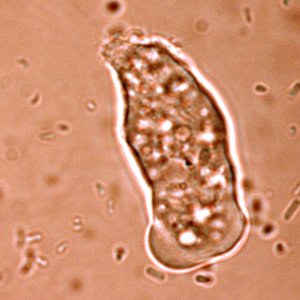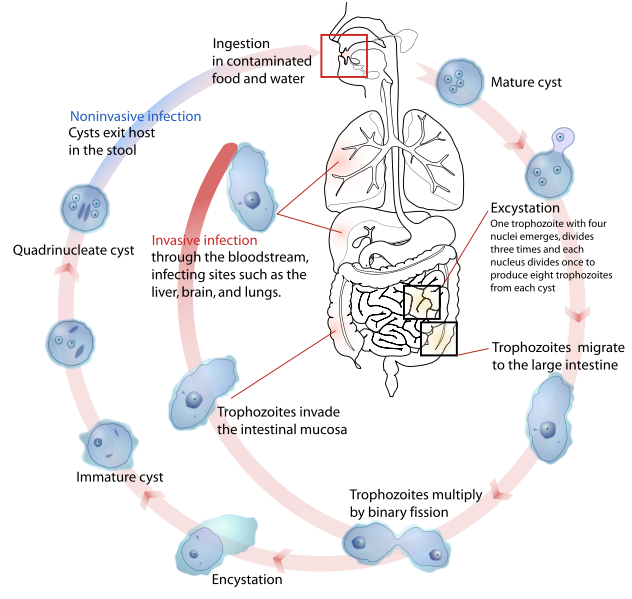Description / Morphology
Entamoeba histolytica is an anaerobic parasitic protozoan that causes amoebic dysentery (an intestinal disorder) when it infects humans. Entamoeba histolytica has trophozoites that range in size from 20 to 40 micro meters in diameter. They can glide very rapidly by by means of a single pseudopodium that is often extended explosively. They also have cytoplasm with a single nucleus, often with ingested red blood cells and sometimes with luekocytes or bacteria rich in glycogen. Its ribosomes are arranged in helices which aggregate to form characteristically shaped elongated bars with rounded ends. It does not have a mitochondria, but does have a rough endoplasmic reticulum, or a golgi apparatus. It's nucleus vesicular is spherical and can measure from 4 to 7 micro meters in diameter.
Entamoeba histolytica also has cysts which are spherical and can measure from 10 to 16 micro meters in diameter. These cysts have four nuclei when they are matured, and glycogen in a distinct vaculoe in an immature cysts which become more diffused as the cysts mature. Immature cysts also have four chromatoid bodies that disappear as the cysts matures. The nuclei of the cysts are similar to trophozoites.

Distribution / Ecology
The geographic distribution of entamoeba histolytica is worldwide but is more common in temperate and tropical zones. Surveys estimate the infection rate of entamoeba histolytica to be anywhere from 0.2 to 50% and is directly related with sanitary conditions. One tenth of the worlds population which is 500 million people are infected by entamoeba histolytica, with between 50,000 to 100,000 people dying of the infection every year. Most of these deaths occur in underdeveloped parts of the world where sanitation and personal hygiene are lacking.

Growth / Reproduction
Entamoeba histolytica reproduce by using the method of binary fusion and goes through a life cycle as described by the picture below.
Evolution
Entamoeba is said to be somewhat related to Vahlkampfiid amoeba because they have the same ribosomal RNA plasmids and a similar limax locomotory morphology and cyst structure to Vahlkampfiid amoeba. However one thing different is that entamoeba does not produce a flagellate stage, also analysis place the genus distant to the Vahlkampfiid group.
Entamoeba has also been assumed to be an early eukaryote that never acquired a mitochondria, but it has been found that they have mitochondria like organelles. These two organelles are called crypton and mitosome, both are double membraned and contain DNA. Recent studies say that entamoeba are related to Pelomyxa and should be grouped in archamoeba. Other studies show entamoeba placed with Dictyostelium and Mastigamoeba in the sub phylum conosa.

Taxonomy
Taxonomy for Entamoeba Histolytica
Kingdom: Protista
Phylum: Sarcomastigophora
Subpyhlum: Sarcodina
Class: Lobosea
Order: Amoebida
Family: Endamoebidae
Genus: Entamoeba
Species: Histolytica
Human Use / Role in Culture
There are no beneficial uses of entamoeba known humans, although entamoeba DNA of different entamoeba strains are being studied and compared to one another to learn more about this protist and how i can affect humans.
Comments (0)
You don't have permission to comment on this page.